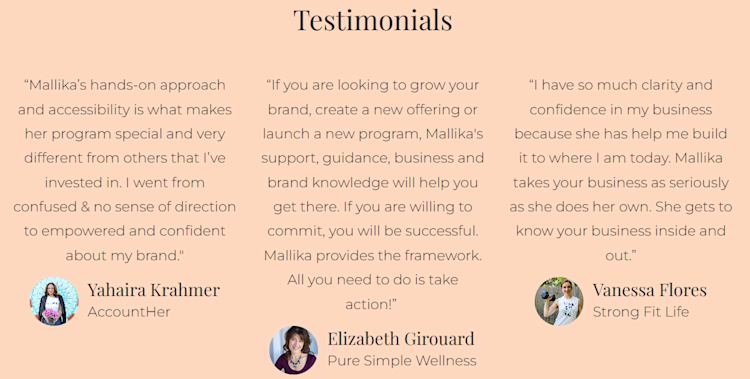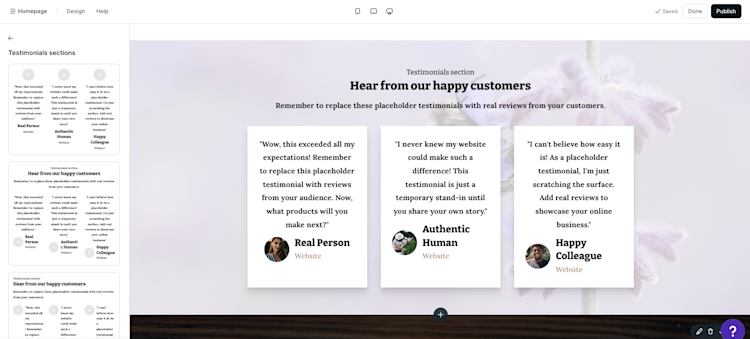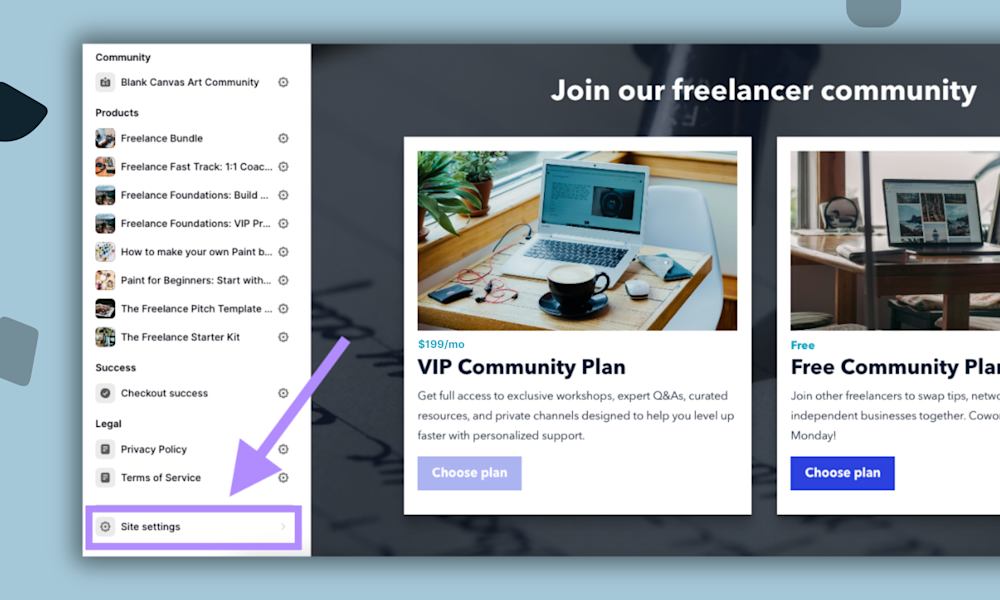Which do you trust more: A billboard on the highway or a recommendation from your best friend?
OK, those are two pretty stark opposites. But when you're marketing your online business, it's a solid comparison to keep in mind.
People trust recommendations from other people way more than they trust traditional advertising. And you can leverage that trust by making customer testimonials a part of your marketing strategy.
All you have to do is figure out who to ask for testimonials . . . and how . . . and when. Plus, the best ways to incorporate those reviews into your marketing materials.
Phew.
Don't worry -- in this article, we'll cover all of that, from finding your happiest customers to creative ways to share their testimonials.
First, let's go over what exactly makes testimonials such an effective marketing tool.
The power of customer testimonials
"One customer, well taken care of, could be more valuable than $10,000 worth of advertising." – Jim Rohn, business philosopher
Customer testimonials can be more effective than even the most amazing, creative, and beautifully written sales page copy.
Here's why: Only a third of people say they trust the brands they buy from. Consumers trust each other more than they trust brands. And 76% of people trust online reviews as much as personal recommendations from family and friends.
Social proof -- showing customers' results and use of your product or service -- shows potential clients what sets you apart.
Sales page testimonials and reviews work especially well for higher-priced products, like expensive online courses and annual memberships.
With all of that in mind, it's clear that customer reviews and referrals can be powerful tools. So, how do you get quality testimonials to use in your marketing materials? Keep reading to find out.
How to ask for testimonials (and actually get them)
The number one rule of getting customer reviews for your online business: Don't be afraid to ask. When you ask the right customers the right questions at the right time, you can get great testimonials to use in your marketing.
First, figure out the best time to ask your current customers for testimonials. Jon Schepke, Vice President of Strategic Partnerships at Reputation.com, recommends requesting testimonials right after customers have completed a purchase or at the end of a project.
That said, if your course or service takes some time for clients to see results, you may want to wait a bit longer before making your request.
Depending on how you want to use the testimonials, there are a few different types of reviews you can ask for.
A quick-written testimonial works well if you want a short, broad quote about your customer's experience. You can also ask more detailed questions for more in-depth testimonials. For example, if you're selling online courses, you might ask your students questions like:
-
Why did you decide to sign up for the course?
-
What were your obstacles before signing up?
-
What was your most valuable takeaway from the course?
-
How has the course changed your business practices/mindset/etc.?
You can send out these questions as an email broadcast to students in a particular course or product, or even build them into your email automations so they go out after a certain amount of time has passed.
If you have specific questions you want answered, a testimonial form through Google Forms, SurveyMonkey, or JotForm works well, too.
However you decide to collect feedback, make sure you get your customers' written permission to post their testimonial on your website, like in the form example above.
You can also ask your customers to hop on a five-minute phone call to share their feedback. Then, turn your notes from the call into a written testimonial. Just double-check that the final wording is okay with your customer before you post it.
You can even ask clients to film a short video testimonial, which can be especially useful for local businesses with in-person services and clients. (We'll share more on how to use video testimonials in the next section.)
Last but not least, don't forget about review sites and social media. Direct satisfied customers to your social media platform of choice, such as Facebook or LinkedIn, or ask that they leave a review on Google or Yelp.
If you find a happy customer on a review site, though, don't copy and paste their testimonial onto your own site. Most review sites have a clause in their terms of service stating that reviews and testimonials are owned by the user and licensed to the website.
Instead, you can link to those review sites on your website or reach out to those customers and ask for written permission to use their testimonials on your website.
You may be tempted to incentivize customer testimonials with a gift card or discount but be careful. A lot of review sites don't allow you to offer money in exchange for reviews.
Plus, the best reviews are unbiased, honest ones because they help prospective customers make the right decision for them.
If you do decide to reward customers who review you, disclose that in the testimonial. Honesty is, as always, the best policy.
Before we move on to putting testimonials into action, here are a few testimonial email templates you can use. Make sure to customize the testimonial for your brand, product or service, and tone of voice -- these are just a starting point.
1. Online course student testimonial request
Here's how this template looks filled out:
2. Online coaching client testimonial request
Here's this template in action:
3. Follow-up testimonial request
Here's what a filled-out version of this template looks like:
OK, with these templates in your toolbox, you're ready to move on to our next section-- how to use those high-quality testimonials to hook new customers.
How to use testimonials to bring in new customers
Customer testimonials are like a Swiss army knife. You can use testimonials across your marketing materials to promote your products and services and bring in new customers.
The most popular way to use testimonials is to add them to your landing pages and sales pages. When you highlight your product's value in your customers' own words, they'll see how much they stand to earn from working with you.
Testimonials on entrepreneur and mindset coach Becky Mollenkamp's coaching page emphasize the value of Becky's product, her coaching services.
Another landing page tip -- when you add testimonials to your website, include headshots of your customers. Putting faces to reviewers' names makes the feedback feel more genuine.
If your customers have businesses and websites of their own, that's even better. Linking to their site in their testimonial benefits both of you. They get a backlink, and the social proof on your page has even more credibility.
Mallika Malhotra shares her customers' business names alongside their testimonials:

Mallika helps entrepreneurs create, develop, and grow their brand. By sharing her customers' websites, potential customers can see Mallika's program in action.
The Podia website builder makes it easy for creators like Mallika to add testimonials to their site. All you have to do is open your site editor and add a new section:

And if you're not using Podia, sign up today to try Podia free for 30 days.
But landing pages and sales page copy aren't the only way to leverage testimonials. If you collect full customer case studies, you can use case studies as lead magnets in exchange for visitors' email addresses.
Author and advertising expert Alana Terry offers five video case studies of her "most profitable Facebook ad campaigns".
The videos promise valuable content for authors who want to advertise on Facebook, and, in exchange, Alana builds her email list. Everybody wins.
Now, let's move beyond your website. If you use social media for your small business, testimonials and user-generated content can make for powerful posts -- especially in video form.
Video is a major piece of content marketing, with 85% of marketers saying video is an effective way to attract attention to online brands and businesses.
When you share testimonial videos on social, keep them short:
-
The ideal length for Facebook videos is about 1 minute.
-
Instagram's time limit is 60 seconds.
-
Twitter has a video length limit of 2 minutes and 20 seconds per tweet.
-
LinkedIn's maximum video length is 10 minutes.
-
68% of viewers will watch a video to the end if it's less than 60 seconds.
Your social post should link to your product page or testimonials page. That way, you'll hook prospective customers with the video, then bring them onto your site for more info on the awesome product or service they just heard all about.
All in all, you can use customer feedback almost anywhere you want to promote your business. Don't be afraid to get creative and make your customer's voice a big part of your brand.
How to get (and use) testimonials and reviews
For small business owners, a good testimonial is worth more than its weight in gold. People trust other people's feedback more than they trust brands -- even when those people are total strangers.
Here's how to collect -- and use -- customer testimonials:
-
Ask your customers for feedback after their purchase or when they can expect to see results from your service or course.
-
Make it easy for customers to share their testimonials through a form, a quick phone call, or a link to a social media platform or review site.
-
Always get customers' permission to share their feedback in your marketing materials.
-
Add testimonials to your website to boost conversions and prove your product's value.
-
Share video testimonials on social media to hook audience interest before linking to your website.
With all of that in mind, you're ready to make social proof a powerful part of your marketing arsenal.
Keeping your customers top of mind is always the right choice -- and when they know you care about their feedback, they'll be more likely to keep sharing it. Now that's what I call a win-win.
Ready to get started? You can set up your website, online store, digital products, and email list all in one place with Podia. Start your 30-day free trial today.



